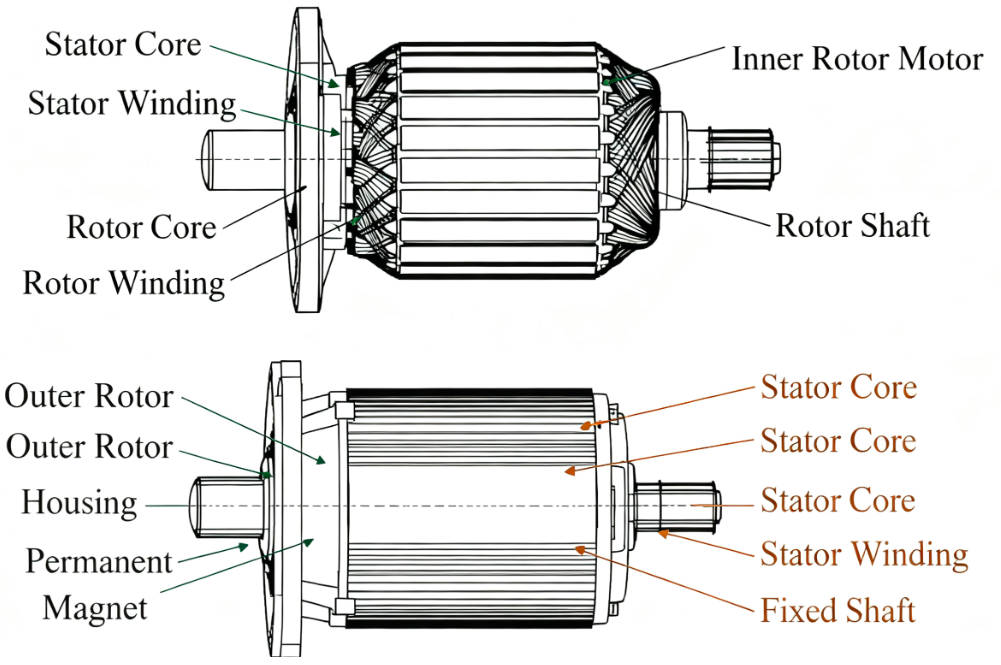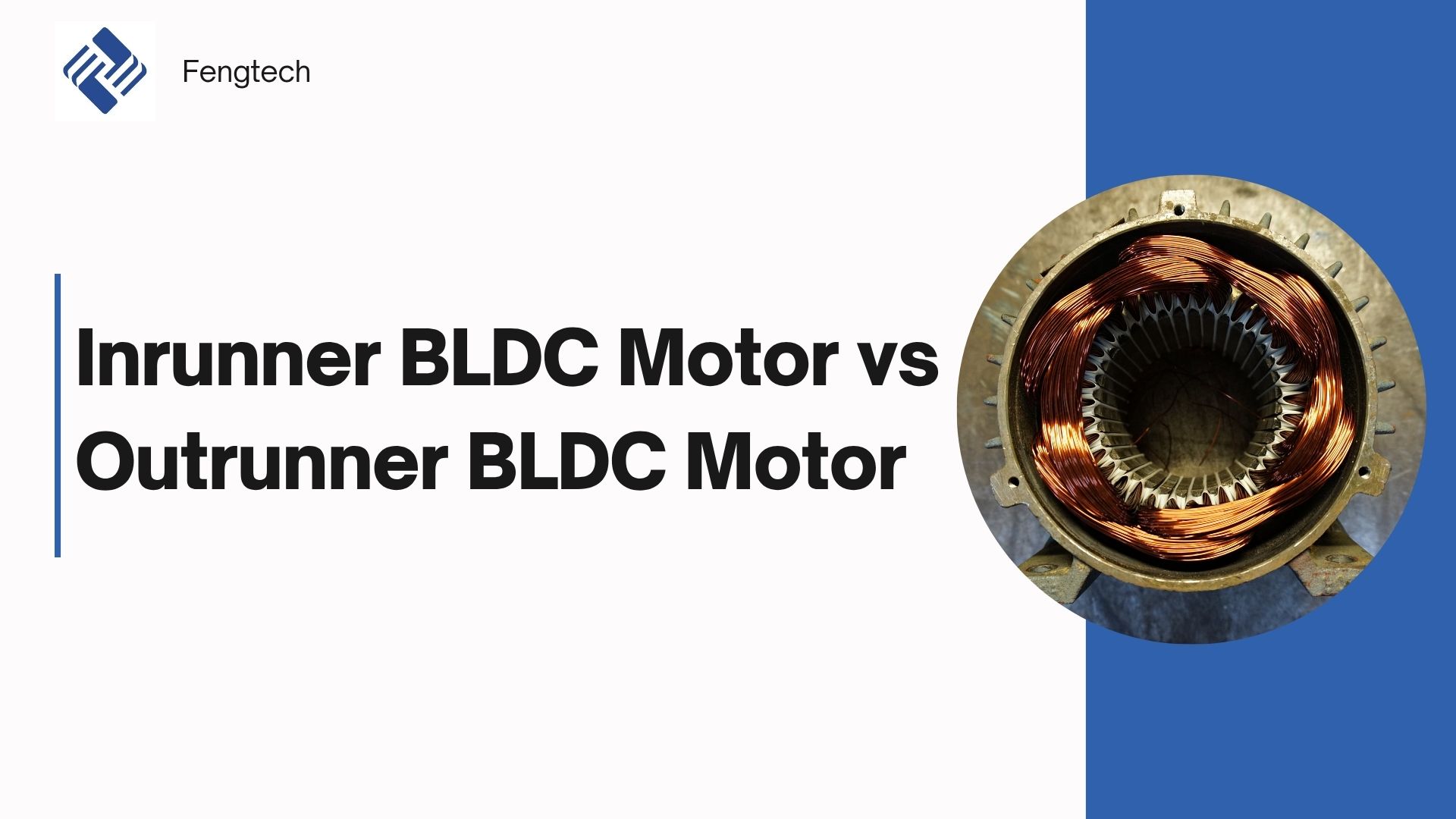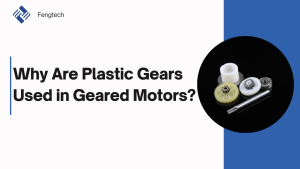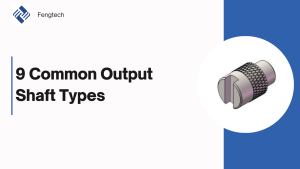When deciding between an outrunner bldc motor and an inrunner bldc motor for your accessory, we’ll provide the answer you need to consider.
The simple conclusion:
For speed, choose an internal rotor motor.
For torque, choose an external rotor motor.
What is a BLDC motor?
A BLDC motor consists of a motor (stator and rotor), a controller, and a position sensor. It lacks traditional brushes and a mechanical commutator. Compared to brushless motors, it offers high efficiency, long life, and low noise. This has led to its increasing application, particularly in the medical, industrial automation, and automotive industries.
Of course, BLDC motors also have some disadvantages, such as the requirement for an electronic controller, a relatively complex internal structure, and higher costs.
Inrunner BLDC Motor vs Outrunner BLDC Motor

Inrunner BLDC Motor
Structure:
Rotor: The permanent magnet rotor is located at the center of the motor.
Stator: The stator coils are wrapped around the rotor.
Operation:
When energized, the stator coils generate a rotating magnetic field that attracts or repels the permanent magnet rotor, causing it to rotate. The motor shaft is directly connected to the rotor, so the rotor drives the shaft.
Applications:
Drones, wind turbines, power tools
Outrunner BLDC Motor
Structural Features:
External Rotor: The permanent magnet rotor is a cup-shaped structure wrapped around the exterior.
Internal Stator: The stator coil is located in the center of the motor and is stationary.
Operation:
Current is applied to the stator coil to generate a rotating magnetic field, which drives the external permanent magnet “housing” to rotate. The motor shaft is fixed to the center of the stator inside, and the rotating housing directly drives the load.
Applications:
Blowers, ceiling fans, cooling fans, propeller motors
* Comparison of different parameters
| Feature | Inrunner | Outrunner | Core Reason |
|---|---|---|---|
| Structure & Size | Slender and compact; small rotor moment of inertia | Short and thick (flat); large rotor moment of inertia | Differences in rotor position and diameter |
| Speed & KV Value | High rotational speed; typically has a high KV value | Low rotational speed; typically has a low KV value | Small rotor diameter leads to low linear speed, requiring higher rotation |
| Torque | Relatively low torque | High torque; high torque density | Outrunner structure provides a larger force arm |
| Heat Dissipation | Stator is external, with large heat dissipation area and good performance | Stator is internal; heat accumulation occurs, making heat dissipation a challenge | Different positions of the core heat-generating components |
| Weight & Efficiency | Usually lighter; high efficiency in high-speed ranges | May be heavier (due to outer magnetic housing); high efficiency in low-speed, high-torque ranges | Differences in design and application objectives |
| Typical Applications | RC models (speed boats, racing aircraft), CNC spindles, blowers | Drones, multi-rotors, RC aircraft, gimbals, direct-drive hubs | Determined by speed and torque characteristics |
How to Choose?
High speed required – Choose Inrunner Motor.
Examples: Racing drones, high-speed vacuum cleaners, power tools.
High torque required at low speed – Outrunner Motor.
Examples: Drones, aerial photography aircraft, gimbal stabilization, hub motors for electric scooters.
Space constraints
Long, narrow spaces: Inrunner Motor is more suitable.
Flat, compact spaces: Outrunner Motor is more suitable.
Heat dissipation conditions
Good air/water cooling: Inrunner Motor has a clear advantage.
Enclosed spaces: Exercise caution when selecting Outrunner Motor and consider additional cooling measures.
FAQs
Q1: Does the Outrunner motor’s slow speed mean it performs poorly?
A1: No. It directly outputs high torque at a low speed, eliminating the need for a speed reduction mechanism in many applications, resulting in greater simplicity and efficiency.
Q2: Can I use an Inrunner motor as an Outrunner?
A2: Absolutely not! The structures are completely different; the fixed and rotating components are reversed.
Q3: Why are Outrunners so commonly used in high-end drones?
A3: Because they require the highest thrust-to-weight ratio and torque for maneuverability, and the Outrunner’s characteristics are a perfect match.
Q4: Which is more durable?
A4: Durability depends largely on build quality, bearings, and the operating environment. In theory, both can be very durable.






